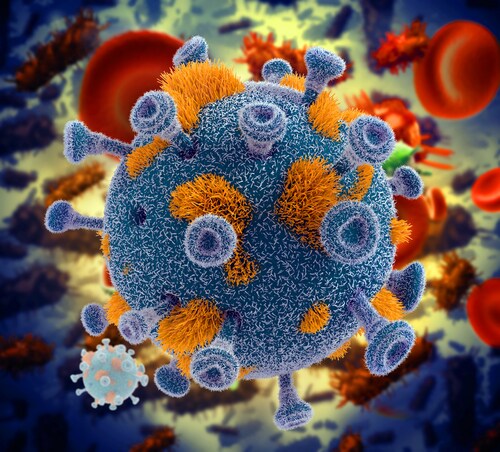 Antiretroviral therapy is effective for both the treatment and prevention of HIV/AIDS. Most clinicians prescribe an antiretroviral cocktail that combines two nucleoside/nucleotide reverse transcriptase inhibitors (NRTIs) with a non-nucleoside reverse transcriptase inhibitor (NNRTI) or a protease inhibitor (PI). As with many drugs, patient non-adherence (including non-disclosure or inaccurate self-reporting) to treatment regimens can lead to treatment failure, a negative impact on clinical trials, and even the emergence of drug-resistant strains.
Antiretroviral therapy is effective for both the treatment and prevention of HIV/AIDS. Most clinicians prescribe an antiretroviral cocktail that combines two nucleoside/nucleotide reverse transcriptase inhibitors (NRTIs) with a non-nucleoside reverse transcriptase inhibitor (NNRTI) or a protease inhibitor (PI). As with many drugs, patient non-adherence (including non-disclosure or inaccurate self-reporting) to treatment regimens can lead to treatment failure, a negative impact on clinical trials, and even the emergence of drug-resistant strains.
Marzinke et al. (2014) describe the application of high-resolution mass spectrometry (HRMS) for simultaneous qualitative detection of 15 antiretroviral agents in human blood, for the purpose of retrospective assessment.1 In the case of patient non-compliance, this approach offers a unique advantage: the option to screen for analytes after the fact using the full-scan data.
The researchers composed stock solutions using NRTIs (emtricitabine, lamivudine, tenofovir and zidovudine), NNRTIs (efavirenz and nevirapine) and PIs (amprenavir, atazanavir, darunavir, indinavir, lopinavir, nelfinavir, ritonavir, saquinavir and tipranavir), as well as external reference molecule morphine-D3. They used these to create working solutions to determine retention times for each analyte. Then, the team combined the master stock solutions and human serum to a final concentration of 100 μg/mL and added 300 μL acetonitrile containing morphine-D3 (125 ng/mL). They subjected these samples to centrifugation, drying and reconstitution with water (150 μL) before aliquoting (30 μL) for chromatographic separation.
For separation, Marzinke et al. used an Aria TLX-1 system and Aria OS software with a Hypersil GOLD PFP (100 × 3 mm, 3 μm particle size) column (all Thermo Scientific). Total run time was 16 minutes at a 500 μL/min flow rate. For detection, they relied upon the Q Exactive Hybrid Quadrupole-Orbitrap mass spectrometer (Thermo Scientific), with one ultra-high-resolution full scan (100,000 @ 1 Hz) and one in-source collision-induced dissociation (CID) enhanced resolution scan (25,000 @ 4 Hz). The team used Mass Frontier software revision 7.0 for fragment prediction and Xcalibur software revision 2.2 and ToxID software revision 2.1.1 for data analysis (all Thermo Scientific).
The researchers set strict parameters for identification based on mass accuracy (±5 ppm) and retention time (±0.4 min). These high thresholds resulted in minimal noise and the qualitative detection of even low-concentration analytes. All but zidovudine and efavirenz were identified with automated peak reviews. The limits of identification were 5 ng/mL for amprenavir, atazanavir, indinavir, lopinavir, nelfinavir, ritonavir, saquinavir, tipranavir, lamivudine and nevirapine; 10 ng/mL for emtricitabine, tenofovir, zidovudine and darunavir; and 150 ng/mL for efavirenz. They were unable to observe fragmentation of either tenofovir (<10 ng/mL) or zidovudine (<50 ng/mL) using the optimization constraints that worked for the majority of the analytes.
For signal intensity, the coefficients of variation (CVs) varied from 3.0–20.6% for the high control samples, 3.0–27.5% for the low control samples, and 2% for the internal standard. The maximum CV for retention times was 2.6% for all samples and 1% for the internal standard. The team also evaluated carryover and found no analytical impact from previous analytes, hemoglobin or bilirubin. They did, however, note lipid carryover for all protease inhibitors excluding amprenavir and darunavir.
Finally, Marzinke et al. applied the method to 64 human plasma samples from a phase-III randomized trial (HPTN 052). These samples revealed that all PIs excluding atazanavir and ritonavir were undetected, most likely because these were not commonly prescribed drugs in the study population. For the other eight antiretrovirals, the range for percent agreement (for qualitative detection, as compared with LC-MS/MS) was 89.1%–100%, with disparities the likely result of lower limits of detection for individual analytes.
The researchers posit that their method is sensitive and selective for the qualitative identification of antiretrovirals. They note that the protocol requires minimal sample preparation, but that the sample quality may impact results. The method is directly applicable to the retrospective monitoring of patient adherence to courses of therapy in research settings.
Reference
1. Marzinke, M., et al. (2014, June) “The development and validation of a method using high-resolution mass spectrometry (HRMS) for the qualitative detection of antiretroviral agents in human blood,” Clinica Chimica Acta, 433 (pp. 157–68), doi: 10.1016/j.cca.2014.03.016.
Post Author: Melissa J. Mayer. Melissa is a freelance writer who specializes in science journalism. She possesses passion for and experience in the fields of proteomics, cellular/molecular biology, microbiology, biochemistry, and immunology. Melissa is also bilingual (Spanish) and holds a teaching certificate with a biology endorsement.
Leave a Reply